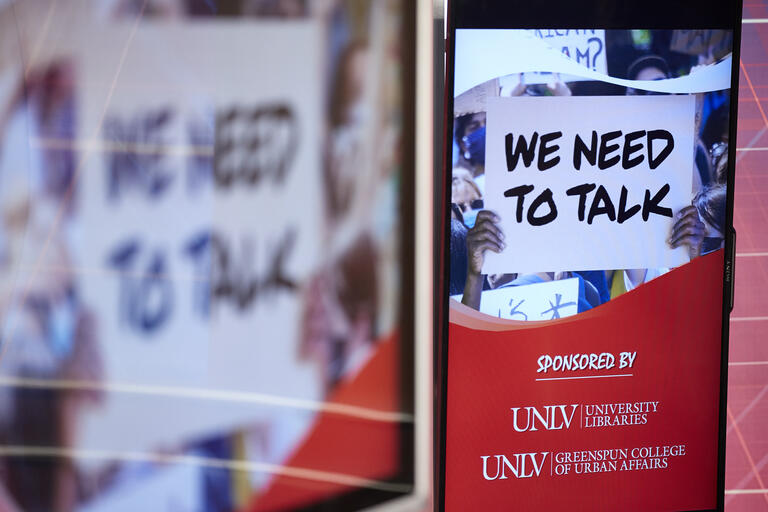One Las Vegas mother might have changed the course of her 4-year-old daughter Hailey's life with an email to the Howard R. Hughes College of Engineering.
Hailey Dawson was born with Poland syndrome, a rare birth defect that causes underdevelopment of the pectoral muscle on one side of the body and deformation of the hand.
The syndrome caused her hand to form with only a thumb and a pinky and nubbins in place of the remaining fingers, resembling the "hang loose" sign.
Hailey calls it her "special hand." She doesn't have the ability to grasp, which makes common childhood activities -- such as riding a bicycle -- difficult and unsafe.
After scouring the Internet, Hailey's mother Yong Dawson stumbled upon Robohand - a cost-effective plastic prosthetic made in a 3-D printer and cobbled together with wire, nuts and bolts.
Inspired by Robohand, Dawson contacted UNLV engineers, hoping that a researcher might take on the project.
"How could you say no to this?" said Brendan O'Toole, chair and professor of mechanical engineering. "The project combines mechanics, robotics, and we get the added bonus of helping someone. It could make all the difference in the world of making Hailey more comfortable or safe."
The plans for the hand are free to the public, so any professional or aspiring engineer can download the design and tinker with it to fit their needs. Nearly 200 people around the world are using the device, according to Robohand's website. Thanks to the entrepreneurial spirit of O'Toole and Mohammed Trabia, associate dean for engineering research, and the ingenuity of a few engineering students, a plastic hand will soon be created for Hailey using UNLV's 3-D printer.
When completed in the next few weeks, the Robohand will be strapped to Hailey's hand and she'll use the muscles in her wrist to control the plastic hand and contract its fingers.
Hailey, like most kids with a Robohand, will need a new hand every year or two as she grows. Because the design is already in the system, engineers can easily scale up the design as she grows.
O'Toole estimates that printing and creating the hand could cost anywhere from $200 to $2,000, a cost that will be covered by UNLV. A prosthetic hand could cost $20,000 to $30,000.
Assisting O'Toole and Trabia on the team is Katherine Lau, a visiting undergraduate student researcher from Rutgers University and a graduate of Palo Verde High School in Las Vegas, who is studying with O'Toole this summer. UNLV engineering student Zack Cook and Claire Ong and Kareem Trabia, students from Advanced Technologies High School in Las Vegas, are learning about engineering at UNLV this summer and are also participating.
Creating the mold
Earlier this summer, Hailey sat patiently in O'Toole's lab so that Lau could take detailed measurements of her hands. Both of Hailey's hands were placed into a bucket of plaster to create a mold, a process that involves staying perfectly still for at least a minute--not an easy task for an active kid who likes watching Disney's Frozen, playing with beads and just learned how to whistle.
"I don't think she really notices that her hand is different and she's adapted very well," Lau said. "She's very proud of her hand and not afraid of it. But I think this will help safety-wise. She will ride a bike and do other two-handed things that are needed in life. It's rewarding to be able to help her."
Hailey's mom, Lau and other researchers sang songs from The Lego Movie and helped Hailey count aloud to 60 to help her stay relaxed while the mold formed.
Lau then took a laser scanner to obtain a 3-D image of both of Hailey's arms. She also measured Hailey using traditional measuring tape.
"I love this because Hailey gets to be here and see the whole process," said Hailey's mom. "They get to know her, see what's she's like and see her personality."
The 3-D printing process
First, engineers will use a 3-D computer modeling program called Solidworks. Then they will input all the measurements, tweak the design to suit Hailey, and send the electronic plans to UNLV's 3-D printer.
Printing the hand will take less than one day. The process of 3-D printing involves extruding layer upon layer of ABS plastic over the same area, building up a 3D composite. The ABS plastic hand will lined with orthoplastic - a moldable, breathable, washable and medically approved plastic for this use. Students will custom mold the hand to Hailey to limit the possibility of skin lesions, infection and injury.
UNLV's mechanical engineering program often uses the 3-D printer to build prototypes for designs or to physically check if one of their designs will function. It's also used to create products for the engineering college's senior design competition, which showcases the inventions of undergraduate students.
O'Toole said he envisions his students working on capstone engineering projects focusing on upgrading the robotic hand designs that would add a mechanism for a greater gripping force or other robotic functions.
Hailey's mother said she hopes this will encourage other families to seek out help for their children with Poland syndrome. She hopes to partner with the College of Engineering to create a foundation that will help kids receive new robotic hands.



